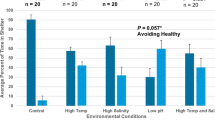Abstract
The tropical periwinkle Planaxis sulcatus (Born, 1778) forms randomly distributed, pyramid-shaped clusters on an intertidal mudflat in eastern Bahrain during the summer. Periwinkle pyramids are observed only on the lower section of the mudflat, where the maximum temperature of the surficial mud is less than about 40 °C, while the upper portion of the mudflat, which experiences temperatures > 52 °C, is barren of gastropods. The periwinkle perched at the apex of the pyramid experiences a temperature that as much as 4° lower than that of the surficial mud. Because we did not observe pyramid-building behavior among Gulf periwinkles during winter, we conclude that pyramid-building behavior in P. sulcatus is a thermoregulatory adaptation.



Similar content being viewed by others
References
Pal, J.S., Eltahir, E.A.B.: Future temperature in southeast Asia projected to exceed a threshold for human adaptability. Nat. Clim. Change 6, 197–200 (2015)
Iacarella, J.C., Helmuth, B.: Experiencing the salt marsh environment through the foot of Littoraria irrorata: behavioral responses to thermal and desiccation stress. J. Exp. Mar. Biol. Ecol. 409, 143–153 (2011)
Feulner, G.R., Hornby, R.J.: Intertidal molluscs in UAE lagoons. Tribulus 16(2), 17–23 (2006)
Muñoz, J.L.P., Finke, G.R., Camus, P.A., Bozinovic, F.: Thermoregulatory behavior, heat gain and thermal tolerance in the periwinkle Echinolittorina peruviana in central Chile. Comp. Biochem. Physiol. Part A 142, 92–98 (2005)
Vaughn, C.C., Fisher, F.M.: Dispersion of the salt-marsh periwinkle Littoraria irrorata: effects of water level, size, and season. Estuaries 15(2), 246–250 (1992)
Iacarella, J.C., Helmuth, B.: Body temperature and desiccation constrain the activity of Littoraria irrorata within the Spartina alterniflora canopy. J. Therm. Biol. 37, 15–22 (2012)
Pazira, A.R., Salehi, H., Obeidi, R.: Identification and investigation of species diversity and richness of the Gastropoda in intertidal zone of Bushehr Port coastal area (the Persian Gulf waters). Iran. J. Fish. Sci. 18(2), 355–370 (2018)
El-Sorogy, A., Youssef, M., Al-Kahtany, K., Al-Otaiby, N.: Distribution of intertidal molluscs along Tarut Island Coast, Arabian Gulf, Saudi Arabia. Pak. J. Zool. 48(3), 611–623 (2016)
Houbrick, R.S.: Anatomy, reproductive biology, and phylogeny of the Planaxidae (Cerithiacea: Prosobranchia). Smithson. Contrib. Zool. 445, 1–68 (1987)
Amao, A.O., Kaminski, M.A., Setoyama, E.: Diversity of Foraminifera in a shallow restricted lagoon in Bahrain. Micropaleontology 62, 197–211 (2016)
Basson, P.W., Murray, J.W.: Temporal variations in four species of intertidal foraminifera, Bahrain, Arabian Gulf. Micropaleontology 41, 69–76 (1995)
Arslan, M., Kaminski, M.A., Tawabini, B.S., Ilyas, M., Babalola, L.O., Frontalini, F.: Seasonal variations, environmental parameters, and standing crop assessment of benthic foraminifera in eastern Bahrain, Arabian Gulf. Geol. Q. 60, 25–35 (2016)
Garrison, T.F.: The mineral collector of the sea: Agglutinella kaminskii n.sp., a new benthic foraminifer from the Arabian Gulf. Micropaleontology 65, 277–283 (2019)
Stirling, H.P.: The upper temperature tolerance of prosobranch gastropods of rocky shores at Hong Kong and Dar es Salaam, Tanzania. J. Exp. Mar. Biol. Ecol. 63, 133–144 (1982)
Janse, C.: The effect of oxygen on gravity orientation in the pulmonate snail Lymnaea stagnalis. J. Comp. Physiol. 142, 51–59 (1981)
Carroll, J.M., Church, M.B., Finelli, C.M.: Periwinkle climbing response to water-and airborne predator chemical cues may depend on home-marsh geography. PeerJ 6, e57744 (2018). https://doi.org/10.7717/peerj.5744
McGuinness, K.: The climbing behavior of Cerithidea anticipata (Mollusca: Gastropoda): the roles of physical and biological factors. Austral. Ecol. 19(3), 283–289 (2006)
Sorte, C.J.B., Bernatchez, G., Mislan, K.A.S., Pandori, L.L.M., Silbiger, N.J., Wallingford, P.D.: Thermal tolerance limits as indicators of current and future intertidal zonation patterns in a diverse mussel guild. Mar. Biol. 166(6), 6 (2019). https://doi.org/10.1007/s00227-018-3452-6
Acknowledgements
The Deanship of Scientific Research, King Fahd University of Petroleum & Minerals, funded the current research through Project IN161002. We thank Andrea M. Garrison and Robert L. Johnson for assistance in the field. We are grateful to Brent Wilson (University of the West Indies), Abduljamiu Amao (KFUPM), Flavia Fiorini (Khalifa University, U.A.E.), and an anonymous reviewer for reading a draft of the manuscript and offering helpful suggestions.
Author information
Authors and Affiliations
Corresponding author
Rights and permissions
About this article
Cite this article
Kaminski, M.A., Garrison, T.F. Thermoregulatory Behavior in the Tropical Periwinkle Planaxis sulcatus. Arab J Sci Eng 45, 4817–4822 (2020). https://doi.org/10.1007/s13369-019-04300-z
Received:
Accepted:
Published:
Issue Date:
DOI: https://doi.org/10.1007/s13369-019-04300-z




